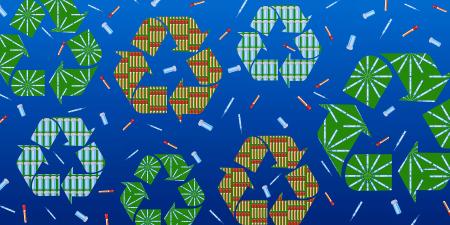Abstract
Health care generates a lot of waste that enters landfills, oceans, and incinerators and adversely affects the health of persons and communities close to waste processing and disposal areas. This article considers the nature and scope of individuals’ and organizations’ disposal responsibilities and discusses personal protective equipment use and waste during the COVID-19 pandemic.
Introduction
Health care generates large amounts of medical waste.1 Where does it go? Our health care products often find their way into landfills and oceans or are incinerated. Hazardous waste (ie, infectious, radioactive, or toxic), sharps waste, and nonhazardous waste (eg, disposable gowns, gloves, and shields) result in approximately 29 pounds of waste per hospital bed per day in the United States alone.1 The COVID-19 pandemic has accelerated both production and use of disposable personal protective equipment, or PPE (eg, masks, gloves, eye protection, and face shields) in both health care and public settings, as the use of multilayer cloth or surgical masks has been found to substantially reduce infections.2 At the same time, nations have reported a steep increase in medical waste since the onset of the pandemic,3,4,5 with a November 2020 Catalonia government report noting a 350% increase in medical waste largely from masks and gloves.3 An estimated 1.56 billion discarded face masks flooded oceans in 2020 due to overburdened or nonexistent waste management and improper disposal.4
Demand to protect oneself and others from a deadly pandemic while minimizing harmful waste highlights a tension in ethics and moral responsibility between public health and environmental sustainability. We will examine personal, professional, and societal obligations that guide decision making through 2 cases: an essential worker following public health masking mandates without thought for sustainability and a sustainability-conscious health care worker experiencing changing PPE rules within a health care institution.
Sustainable Masking?
Case 1. Serena works full time as a checker at her local grocery store where masking of both employees and customers is mandated by the store. She works 8-hour shifts wearing single-use disposable surgical masks that are provided by her employer. She will often change masks a few times per shift if she sneezes or otherwise soils the mask. And she often takes extra masks from work to use elsewhere (eg, the post office or the dentist), discarding the mask after use. She has noticed that trash bins are overflowing with masks and wonders where they go. Some of her friends have purchased reusable masks but, given the supply she has through work, she does not feel the need to purchase other masks.
Discussion. In the winter and spring of 2020, as the novel coronavirus, or SARS-CoV-2, spread worldwide, countries and municipalities introduced measures for public safety, including recommendations or mandates for mask use. To date, such regulations have been carried out to varying degrees.5 As of August 2022, there have been more than 584 million cases of COVID-19 worldwide with more than 6.4 million deaths, making concerted efforts to mitigate spread of the virus a continued necessity.6
Public health guidance on mask wearing has had the unintended consequence of producing an overabundance of discarded face masks. An estimated 129 billion face masks are used, and presumably disposed of, globally per month, which is equivalent to 3 million masks-per-minute.7 Nearly all single-use, disposable surgical masks are made from layers (20 or 25 grams per square meter in density) of microsize polypropylene fibers.8 Disposal of these masks is known to have negative effects on environmental and public health. The plastic in the masks degrades into micro-and nano-plastics. When these enter the waste stream, the particles accumulate in marine organisms and later in humans through indirect ingestion.9 Studies analyzing urine levels of chemicals found in some plastics (eg, bisphenol A [BPA]) have found an association between higher urine BPA levels and heart disease, suggesting potential harms of long-term exposure.10 Prior to the pandemic, it was estimated that the average person consumed a credit card’s worth of plastic (5 grams) per week because of increasing plastic disposal and subsequent ingestion.9 It is reasonable to assume that this amount may rise with the accumulation of improper PPE disposal.
Alternatives to single-use masks are available. Although sustainability metrics can differ for reusable and disposable masks, analysis has shown that embedded filtration in reusable masks has a better sustainability profile than single-use disposable surgical masks.11
In the case presented above, Serena abides by public health regulations and the rules of her workplace by wearing the single-use, disposable surgical masks provided to her. She respects the value of these rules in protecting human health and saving lives by limiting the spread of COVID-19; yet she is not made aware of the environmental impact of her decision to dispose of several masks daily and thus is unable to perceive a need to mitigate—or to advocate for mitigation of—this impact.
Serena’s case highlights how ease of use, availability of supplies, and lack of public education can direct individuals toward less sustainable choices. In addition to making an appropriate mask supply available to the general population, institutions and public health officials should appropriately counsel members of the public and guide them toward choices that additionally account for environmental sustainability. For example, while countries such as the United States and the United Kingdom provide basic guidelines on caring for reusable masks and disposing of single-use masks,12,13 they miss an opportunity to provide advice regarding the sustainability or environmental impact of choosing disposable masks.
Case 2. Eddie is a nurse on a medical unit. When the pandemic started, he and others were worried they would not have enough N-95 respirators. They were told initially to reuse their masks, with each nurse assigned a plastic bin to store masks between shifts. The hospital then devised a decontamination strategy, and he and others began putting used masks into a bin to be reused after decontamination. Several months into the pandemic, he noticed that all these measures had stopped. He was instructed to use an N-95 once, then throw it into the waste bin, the contents of which were destined for incineration or a secure landfill. When he asked his nursing supervisor what had changed, he was told that the hospital administrators and supply chain directors had an abundant supply of masks, making decontamination and reuse measures unnecessary.
Discussion. The COVID-19 pandemic has changed the rules of mask and other PPE use. Infection mitigation strategies have required PPE for nearly every in-person patient encounter. As case numbers fluctuated and vaccination rates remained uneven across the country, the Centers for Disease Control and Prevention (CDC) recommended in February 2022 that health care professionals continue wearing masks in clinical settings.14 Some also argue that respirator and mask usage will persist in health care settings beyond the pandemic.15
Unfortunately, such recommendations have environmental and financial costs. It is estimated that the COVID-19 pandemic generates approximately 7200 tons of medical waste per day globally, with a sizeable portion attributable to masks.16,17 In most facilities, this (biohazardous) medical waste will be incinerated or routed to a secure landfill. Although better than unregulated disposal, both disposal routes have significant environmental impacts. Incineration is known to be a major contributor to freshwater aquatic ecotoxicity and human toxicity potential, whereas landfills have the potential to leak pollutants into groundwater.18,19
In the early months of the pandemic, N-95 respirator masks and disposable masks were in short supply. To maximize resources, health care professionals extended the use of masks, wearing one mask per day instead of switching to a new mask for each patient.20 In 2020, many health care systems, including Stanford and Partners HealthCare, also implemented decontamination and repurposing strategies, such as ultraviolet germicidal irradiation (UVGI) and concentrated hydrogen peroxide vapor (H2O2), which were implemented at an outside facility (Battelle), allowing for N-95 respirator masks to be sterilized and reused.21,22 The University of Nebraska designed a pilot UVGI system that was approved by the CDC, which encouraged hospitals with ultraviolet decontamination systems to implement the practice.23,24 However, efforts to reuse respirator masks largely fell aside as supply increased.
It has been estimated that if each health care professional had used a new N-95 mask for each patient, 84 million kilograms of waste (an equivalent of 252 Boeing 747 airplanes)would have been produced during the first 6 months of the pandemic.25 With reusable mask strategies, including both reusable N-95 masks and filters, waste production during the first 6 months of the pandemic could have been reduced by an estimated 98%—to as little as 1.6 million kilograms (5 747 airplanes).25
Eddie’s case highlights how the definition of a “crisis” can be narrow and miss an opportunity to continue to improve resource use. With the Intergovernmental Panel on Climate Change declaring code red for humanity and an emerging international consensus on the need for national targets on the reduction and management of plastics production,26,27 the end of the pandemic does not signal the end of crisis mode. We may finally confront a crisis that has loomed for too long.
Conclusion
If masks were reusable in perpetuity, there would be less ethical conflict regarding their use. As these cases highlight, disposable masks leave both a carbon footprint in production and an indelible imprint on the environment when disposed of due to the indestructible nature of plastics. Moreover, masks are often improperly discarded due to infrastructure constraints, with unsustainable amounts of waste ending up in oceans. Although disposable masks can be easier to procure or manage as they do not require washing or maintenance, individuals seeking to follow public health or institutional directives may choose them without cognizance of their unintended environmental consequences.
The COVID-19 pandemic has exacerbated social and cultural tendencies to use single-use PPE products that have enormous environmental impact. Responding to pandemic use patterns, however, now presents opportunities to reassess assumptions and habits and encourage public health measures that effectively protect us all from threatening infectious diseases while prioritizing environmental impact minimization.
References
-
2021 sustainability benchmark report. Practice Greenhealth; 2021.
- Brooks JT, Butler JC. Effectiveness of mask wearing to control community spread of SARS-CoV-2. JAMA. 2021;325(10):998-999.
-
Municipal waste management and COVID-19. Association of Cities and Regions for Sustainable Resource Management. Updated November 18, 2020. Accessed March 10, 2022. https://www.acrplus.org/en/municipal-waste-management-covid-19#data_catalonia
-
1.56 billion face masks pollute ocean in 2020. Oceanic Worldwide blog. January 19, 2021. Accessed July 5, 2022. https://www.oceanicworldwide.com/blog/1-56-billion-face-masks-pollute-ocean-in-2020/?v=7516fd43adaa
- An BY, Porcher S, Tang SY, Kim EE. Policy design for COVID-19: worldwide evidence on the efficacies of early mask mandates and other policy interventions. Public Adm Rev. 2021;81(6):1157-1182.
-
WHO coronavirus (COVID-19) dashboard. World Health Organization. Updated August 9, 2022. Accessed August 10, 2022. https://covid19.who.int/
-
Xu EG, Ren ZJ. Preventing masks from becoming the next plastic problem. Front Environ Sci Eng. 2021;15(6):125.
-
Henneberry B. How surgical masks are made, tested and used. Thomas. Accessed July 2, 2022. https://www.thomasnet.com/articles/other/how-surgical-masks-are-made/
-
De Wit W, Bagaud N; Dalberg Advisors. No plastic in nature: assessing plastic ingestion from nature to people. World Wide Fund for Nature; 2019. Accessed July 5, 2022. http://awsassets.panda.org/downloads/plastic_ingestion_press_singles.pdf
-
Melzer D, Rice NE, Lewis C, Henley WE, Galloway TS. Association of urinary bisphenol A concentration with heart disease: evidence from NHANES 2003/06. PloS ONE. 2010;5(1):e8673.
-
Lee AWL, Neo ERK, Khoo ZY, et al. Life cycle assessment of single-use surgical and embedded filtration layer (EFL) reusable face mask. Resour Conserv Recycl. 2021;170:105580.
-
Face coverings: when to wear one, exemptions, and how to make your own. GOV.UK. Updated January 27, 2022. Withdrawn April 1, 2022. Accessed October 26, 2021. https://www.gov.uk/government/publications/face-coverings-when-to-wear-one-and-how-to-make-your-own/face-coverings-when-to-wear-one-and-how-to-make-your-own#maintaining-and-disposing-of-face-coverings
-
COVID-19: use and care of masks. Centers for Disease Control and Prevention. Updated February 25, 2022. Accessed August 10, 2022. https://www.cdc.gov/coronavirus/2019-ncov/prevent-getting-sick/about-face-coverings.html
-
Lee JC, Ozaki A, Ozaki W. The impact of COVID-19 on the personal protective equipment practices and preferences of craniofacial surgeons. Plast Reconstr Surg Glob Open. 2021;9(6):e3686.
-
Ranney ML, Griffeth V, Jha AK. Critical supply shortages—the need for ventilators and personal protective equipment during the Covid-19 pandemic. N Engl J Med. 2020;382(18):e41.
-
Klemeš JJ, Fan YV, Tan RR, Jiang P. Minimising the present and future plastic waste, energy and environmental footprints related to COVID-19. Renew Sustain Energy Rev. 2020;127:109883.
-
Chu J, Ghenand O, Collins J, et al. Thinking green: modelling respirator reuse strategies to reduce cost and waste. BMJ Open. 2021;11(7):e048687.
- Atitlan Türkmen B. Life cycle environmental impacts of disposable medical masks. Environ Sci Pollut Res. 2022;29(17):25496-25506.
-
Selvaranjan K, Navaratnam S, Rajeev P, Ravintherakumaran N. Environmental challenges induced by extensive use of face masks during COVID-19: a review and potential solutions. Environ Chall. 2021;3:100039.
-
Karlamanangla S, Chabria A, Baumgaertner E. Despite promises of more masks, doctors and nurses have to reuse N95s. Los Angeles Times. April 14, 2020. Accessed July 5, 2022. https://www.latimes.com/california/story/2020-04-14/coronavirus-ppe-shortage-persists-hospitals
-
Abate T. New website explains how hospitals can decontaminate and reuse scarce N95 masks to fight COVID-19. Stanford News. April 1, 2020. Accessed October 26, 2021. https://news.stanford.edu/2020/04/01/researchers-show-how-to-decontaminate-reuse-n95-masks/
- LABline. Partners HealthCare to launch new N95 mask sterilizing facility. Medical Laboratory Observer. April 8, 2020. Accessed March 10, 2022. https://www.mlo-online.com/disease/infectious-disease/article/21133125/partners-healthcare-to-launch-new-n95-mask-sterilizing-facility.
-
Lowe JJ, Paladino KD, Farke JD, et al. N95 filtering facepiece respirator ultraviolet germicidal irradiation (UVGI) process for decontamination and reuse. Nebraska Medicine. Updated April 10, 2020. Accessed February 21, 2022. https://www.nebraskamed.com/sites/default/files/documents/covid-19/n-95-decon-process.pdf
- Gilbert RM, Donzanti MJ, Minahan DJ, et al. Mask reuse in the COVID-19 pandemic: creating an inexpensive and scalable ultraviolet system for filtering facepiece respirator decontamination. Glob Health Sci Pract. 2020;8(3):582-595.
-
Trafton A. The environmental toll of disposable masks. MIT News. July 20, 2021. Accessed July 5, 2022. https://news.mit.edu/2021/covid-masks-environment-0720
-
Skea J, Shukla PR, Reisinger A, et al; Working Group III. Climate Change 2022: Mitigation of Climate Change. Working Group III Contribution to the IPCC Sixth Assessment Report (AR6). Intergovernmental Panel on Climate Change; 2022. Accessed August 10, 2022. https://report.ipcc.ch/ar6wg3/pdf/IPCC_AR6_WGIII_FinalDraft_FullReport.pdf
-
United Nations. IPCC report: “code red” for human driven global heating, warns UN chief. UN News. August 9, 2021. https://news.un.org/en/story/2021/08/1097362


